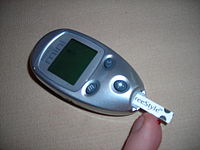
Photo from wikipedia
The aim of this systematic review was to report the evidence on optimal prandial timing of insulin bolus in youths with type 1 diabetes. A systematic search was performed including… Click to show full abstract
The aim of this systematic review was to report the evidence on optimal prandial timing of insulin bolus in youths with type 1 diabetes. A systematic search was performed including studies published in the last 20 years (2002–2022). A PICOS framework was used in the selection process and evidence was assessed using the GRADE system. Up to one third of children and adolescents with type 1 diabetes injected rapid-acting insulin analogues after a meal. Moderate–high level quality studies showed that a pre-meal bolus compared with a bolus given at the start or after the meal was associated with a lower peak blood glucose after one to two hours, particularly after breakfast, as well as with reduced HbA1c, without any difference in the frequency of hypoglycemia. There were no differences related to the timing of bolus in total daily insulin and BMI, although these results were based on a single study. Data on individuals’ treatment satisfaction were limited but did not show any effect of timing of bolus on quality of life. In addition, post-prandial administration of fast-acting analogues was superior to rapid-acting analogues on post-prandial glycemia. There was no evidence for any difference in outcomes related to the timing of insulin bolus across age groups in the two studies. In conclusion, prandial insulin injected before a meal, particularly at breakfast, provides better post-prandial glycemia and HbA1c without increasing the risk of hypoglycemia, and without affecting total daily insulin dose and BMI. For young children who often have variable eating behaviors, fast-acting analogues administered at mealtime or post-meal could provide an additional advantage.
Journal Title: Journal of Personalized Medicine
Year Published: 2022
Link to full text (if available)
Share on Social Media: Sign Up to like & get
recommendations!